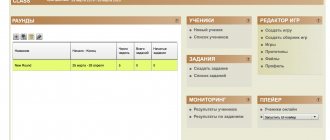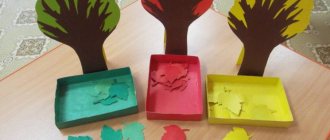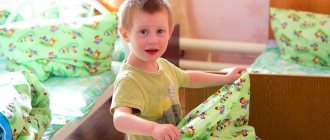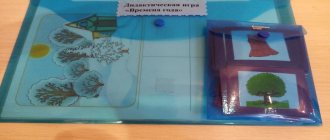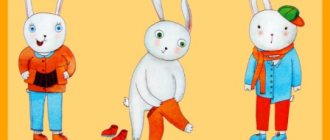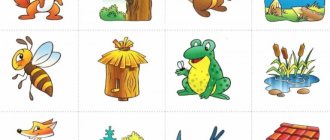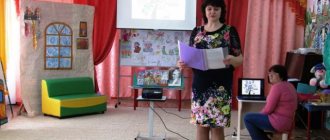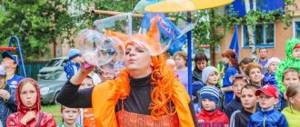Didactic games for children of senior preschool age on the theme “Spring”
PLANNING EDUCATIONAL ACTIVITIES (for the week from March 10 to March 13, 2020)
Subject:
“Spring is red. Primroses"
Final event:
Exhibition of children's works "Spring Drops"
Date of the final event:
Friday 03/13/2020
Responsible for the final event:
Kislova L. B.
| Day of the week | Mode | Integration of educational areas | Joint activities of adults and children, taking into account the integration of educational areas | Organization of a developmental environment for children’s independent activities (activity centers, all group rooms) | Interaction with parents/social partners | |||
| Group, subgroup | Individual | Educational activities in special moments | ||||||
| 1 | 2 | 3 | 4 | 5 | 6 | 7 | 8 | |
| Tuesday - 03/10/2020 | Morning: | Physical development Cognitive development Speech development Social communication. development | Conversation “What changes are happening around us” D/i "Find the differences" Articulation gymnastics. Finger gymnastics “Spring” | With Vova, Lenya - chants - developing voice power Individual work with Sasha Sem. - learning tongue twisters | Dialogue "Spring" Labor: /girls/ wash doll clothes - teach neatness. Memorizing Stuart's poem "Spring Has Come" | Enrich the art corner with illustrations on the topic. Independent activity of children in the activity center. | Conversation “Educational games on the way to kindergarten” Individual conversations at the request of parents | |
| Organizational and educational activities | Cognitive development Artistic and aesthetic development | 1. FEMP “The boat floats, floats” by Kolesnikov, episode 30 Goal: to consolidate the ability to correlate the number of objects with a number, formulate an educational problem, solve examples within the second ten, write in a squared notebook, knowledge of the sequence of days of the week. 2. OOD educational psychologist /according to the plan of the educational psychologist/ 3. Musical /according to the music director’s plan/ | ||||||
| Walk: | Physical development Cognitive development Speech development Social and communicative development Artistic and aesthetic development | Walk No. 1 (Kravchenko) - for seasonal changes Artistic word “Laid down in the fields of a blizzard” P/i “Sunny” - speech with movement P/i “Who will remain in the circle” | With Kamzar, Yarik, Matvey – long jump With Lenya - throwing and catching the ball | Work on the site: clearing the site of snow. KGN: strengthen the ability to fold things after a walk. | Independent activities of children during a walk. Bring out attributes for outdoor and role-playing games. | |||
| work before bed | Reading V. Bianchi “March” | |||||||
| Evening: | Awakening gymnastics. Hardening procedures (walking along a ribbed path) Working with a subgroup of children on instructions from a speech therapist | With a subgroup of boys - d/i “Find the mistake” | Working in a corner of nature: caring for indoor plants Learn the rhyme “Icicles” | Attributes for role-playing games, board games. Independent activities of children in the employment center. | ||||
| Walk | Observation of the evening sky. Independent activity of children with external materials. P/i “Wind, ice and frost.” Role-playing games of children's choice. | |||||||
PLANNING EDUCATIONAL ACTIVITIES (for the week from March 10 to March 13, 2020)
Subject:
“Spring is red. Primroses"
Final event:
Exhibition of children's works "Spring Drops"
Date of the final event:
Friday 03/13/2020
Responsible for the final event:
Kislova L. B.
| Day of the week | Mode | Integration of educational areas | Joint activities of adults and children, taking into account the integration of educational areas | Organization of a developmental environment for children’s independent activities (activity centers, all group rooms) | Interaction with parents/social partners | ||||||
| Group, subgroup | Individual | Educational activities in special moments | |||||||||
| 1 | 2 | 3 | 4 | 5 | 6 | 7 | 8 | ||||
| Wednesday – 03/11/2020 | Morning: | Physical development Cognitive development Speech development Social and communicative development | Communication “Spring has come” - spring phenomena Articulation gymnastics. D/i “Spring months” | With girls - d/i "Pochemuchka" With Kamzar, Misha - d/and graphic dictation | Composing the story “Spring is Red” D/i “When it happens” Labor: involve girls in cleaning up the “Barbershop” | Offer puzzles “Spring” Independent activity of children in the activity center. | Individual conversations at the request of parents. Communication “Discuss the topic of the week!” | ||||
| Organizational and educational activities | Speech development Physical development Cognitive development | 1. FEMP “Be careful, neighbor!” Pomoraeva, lesson 2 Goal: Continue to learn how to independently compose and solve problems involving addition and subtraction within 10. Strengthen your understanding of the relationships between adjacent numbers within 10. Improve your ability to navigate on a sheet of squared paper. Develop attention. 2. Indoor physical education /according to the physical instructor’s plan/ 3. Speech development Compose a story on the theme “Spring” using reference pictures. S. Karpova p.99; O.S. Ushakova p.348 Goal: expand children’s ideas about spring, teach them to talk about its signs, write a descriptive story, develop memory, attention, and thinking. | |||||||||
| Walk: | Physical development Cognitive development Speech development Social and communicative development Artistic and aesthetic development | Observation No. 2 (Kravchenko) - of a sparrow Artistic word: “In a ditch with melt water” P/i "Migration of birds" P/i “Sunny” - speech with movement | With Lenya, Timofey, Kamzar - rolling a hoop in any direction. | Labor: we spread the remaining snow so that it melts faster. | Bringing equipment to the site for children to play independently. Free play for children in the fresh air. | ||||||
| work before bed | Reading the story by Sokolov-Mikitov “Spring is Red.” | ||||||||||
| Evening: | Awakening gymnastics. Hardening procedures (walking along a ribbed path) With 1 subgroup of children - ex. for breathing Dramatization of the fairy tale "The Three Little Pigs" | With Vova, Kamzar, Misha - retelling of the story “Spring” With Matvey - shading of letters. | Role-playing game “Visiting a fairy tale” Repeat the rhyme “Icicles” | Coloring pages and stencils on the topic. Board-printed games Children's games in a corner of nature | |||||||
| Walk | A conversation about the benefits of walking. Independent games with external material. P/i “It flies or doesn’t fly” | ||||||||||
PLANNING EDUCATIONAL ACTIVITIES (for the week from March 10 to March 13, 2020)
Subject:
“Spring is red. Primroses"
Final event:
Exhibition of children's works "Spring Drops"
Date of the final event:
Friday 03/13/2020
Responsible for the final event:
Kislova L. B.
| Day of the week | Mode | Integration of educational areas | Joint activities of adults and children, taking into account the integration of educational areas | Organization of a developmental environment for children’s independent activities (activity centers, all group rooms) | Interaction with parents/social partners | |||||
| Group, Subgroup | Individual | Educational activities in special moments | ||||||||
| 1 | 2 | 3 | 4 | 5 | 6 | 7 | 8 | |||
| Thursday – 03/12/2020 | Morning: | Physical development Cognitive development Speech development Social and communicative development | Conversation "Best Friend" D/i “My mood” Articulation and breathing exercises | With Vova, Kamzar – d/i “Complete sentence” With Kamzar - labyrinths | D/i “Find a place” /numbers/ KGN - to teach children to pay attention to their appearance. Work in a corner of nature: find out which plants need watering. | Independent activity of children in the activity center. Offer stencils of birds for decorating spring landscapes. | Propose the creation of an album “Spring” Invite parents to play board games. | |||
| Organizational and educational activities | Speech development Artistic and aesthetic development Physical development | 1. Speech development “Spring is coming.” Reading stories and poems about spring. O.S. Ushakova, s. 122, 192 Goal: to evoke in children a feeling of admiration and admiration for the beauty of their native nature. The desire to express one’s experiences and impressions in words: to teach one to emotionally perceive the figurative content of art. texts. 2. Speech therapy according to the plan of the speech therapist/ 3. Modeling “Primroses”/compendium/ Goal: to create conditions for making a decorative clay plate, apply it in an even layer on cardboard, then draw a pattern in stacks, applying clay in accordance with the pattern. 4. Outdoor physical education / according to the physical instructor's plan/ | ||||||||
| Walk: | Physical development Cognitive development Speech development Social and communicative development Artistic and aesthetic development | Observation #4 Monitoring the work of the janitor. P/i “Run to the flag” P/i "Crow and Sparrow" | With Maxim, Leva, Samandar – long-distance throwing With Matvey - jumping on two legs. | Rules for safe behavior on Trud Street on the site: cleaning up branches cut off by a janitor. | Games with external material. Independent activity during a walk. Role-playing games, children's wishes. | |||||
| work before bed | Reading the fairy tale “The Town Musicians of Bremen” by B. Grimm | |||||||||
| Evening: | Awakening gymnastics. Hardening procedures (walking along a ribbed path) Work on instructions from a speech therapist Memorizing Belozerov's "Snowdrops" | With Kamzar, Misha, Lenya – chants /intonation expressiveness/ | KGN: dry yourself properly with a towel. Pal/theater "Kolobok" | Printed board games, puzzles, construction sets, dominoes. Children's independent games in the activity center. | ||||||
| Walk | Independent play activities on the site. Game exercise “If I met in the forest...” Children's games with external materials. | |||||||||
PLANNING EDUCATIONAL ACTIVITIES (for the week from March 10 to March 13, 2020)
Subject:
“Spring is red. Primroses"
Final event:
Exhibition of children's works "Spring Drops"
Date of the final event:
Friday 03/13/2020
Responsible for the final event:
Kislova L. B.
| Day of the week | Mode | Integration of educational areas | Joint activities of adults and children, taking into account the integration of educational areas | Organization of a developmental environment for children’s independent activities (activity centers, all group rooms) | Interaction with parents/social partners | |||||
| Group, subgroup | Individual | Educational activities in special moments | ||||||||
| 1 | 2 | 3 | 4 | 5 | 6 | 7 | 8 | |||
| Friday – 03/13/2020 | Morning: | Physical development Cognitive development Speech development Social com. development | Conversation “I have a best friend” D/game “Say a word” Articulation gymnastics Breathing hymn. | With Kamzar, Sasha Sem., Misha - d/i “Complete sentence” | Consolidating the names of the spring months. Labor: keeping children on duty in the cafeteria and in classes | Reviewing books and encyclopedias on the topic. Offer printed board games: dominoes, puzzles. Independent activity of children in the activity center. | Invite parents to bring story pictures on the topic to create the “Spring” album Conversation with parents on working with books “Methods of looking at illustrations, retelling, and learning poems by heart” | |||
| Organizational and educational activities | Cognitive development Artistic and aesthetic development | 1. Cognitive development “Admire: spring is coming” O.A. Solomennikova, p.58 Goal: to arouse in children the joy of perceiving the poem, improve expressive reading skills, help them assimilate the content of “poems about spring,” and highlight the signs of the season described in them. 2. Speech therapy according to the plan of the speech therapist/ 3. Musical /according to the music director’s plan/ | ||||||||
| Walk: | Physical development Cognitive development Speech development Social and communicative development Artistic and aesthetic development | Observation No. 4 – of a passenger car (Kravchenko). Artistic word “The buses are in a hurry...” P/i “Don’t get your feet wet”, “Twisting path” | Exercise with the ball “Greedy” (Lenya, Vova, Darina) With Matvey - throwing at the target | Work on the site: cleaning the children's site from debris. KGN: strengthen the ability to fold things after a walk. | Games with external material. Independent activity during a walk. Role-playing games, children's wishes. | |||||
| work before bed | Quiz "Pets" | |||||||||
| Evening: | Awakening gymnastics. Hardening procedures (walking along a ribbed path) Game "Bragging" Work on instructions from a speech therapist. | With Kamzar, Samandar, Sasha Sem. – memorizing Ladonshchikov’s poem “Spring” | Labor: “Helpers” - general cleaning in corners - ability to work together in a team. | Exhibition of children's works "Spring drops" Printed board games, puzzles, construction set. Children's independent games in the activity center. | ||||||
| Walk | Weather observation. Outdoor game “Tag-chases” P/i “Forged chains” Free activities for children on the street. | |||||||||
Event Planning Table
A properly created calendar lesson plan will help the teacher correctly distribute daily classes without burdening the children.
Note! The long-term lesson plan should include projects that allow children to learn about spring changes in nature.
GCD on the theme “Spring”
The theme of the NOD “Spring” carries the idea of developing speech, logic, artistic abilities, interest in learning music and physical skills. Regular walking is also added.
Drawing a portrait
The program includes:
- Didactic games (role-playing games, for example, “Family”, “Mommy”, etc.). They can be combined with physical exercise.
- Cognitive activity - it includes simple mathematical examples, the ability to write down the conditions of problems using numbers and signs.
- Artistic and aesthetic development - drawing pictures on a specific topic. This activity has the goal of teaching a child to draw a portrait conveying the features of appearance.
- Walking with outdoor games will provide an opportunity to develop curiosity, communication skills, artistic traits, a sense of beauty, physical and speech development. It can be combined with work activity, for example, clearing flower beds of dried grass that has already stopped blooming.
Additional Information. The methods used are games, fairy tales and the inclusion of children in collective activities. Individual work is also important, allowing each child to express himself in games.
Progress:
- “Guys, what do you know about spring?” (Children name natural phenomena associated with spring).
- “That’s right, now I’ll show you a blossoming branch, and we’ll draw it using plasticine.”
Note! It is important to engage children in the activity by focusing on changes in nature during early spring.
Modeling classes “Spring”
The lesson program includes developing the concept of “spring” in children.
Its goal is to develop the ability to sculpt a tree branch using plasticine. This will foster a love of nature and awaken in children the desire to convey beauty through creativity.
The materials used are a picture of a spring tree, cardboard, plasticine, and stacks.
Modeling is useful for developing motor skills
The lesson goes as follows:
- First, the teacher gives the children riddles about spring.
- “Let's get to work. In front of you are sheets of cardboard and a box of plasticine. We will roll sausages out of brown plasticine, make the trunk and branches of a tree out of them, pressing the plasticine to the cardboard” (the teacher needs to demonstrate the process).
- “Now let’s get to the flowers. First we’ll make the middle - we’ll roll yellow plasticine into balls and place them on the branches of the tree.”
- “Now we make the stamens. Roll out the sausage from yellow plasticine, use a cutting stick to cut it into small pieces and roll them into balls. They fill the middle."
- “The next step is to design the petals. Divide the pieces from white or pink plasticine into equal parts using a stack; you need to roll the balls and flatten them, pinching them at the bottom. You need to make 5 pieces, making a flower. Roll a sausage out of green plasticine, divide it into equal parts, flattening them on one side. Next, each leaf is flattened at the ends so that one end is sharp and the other is pinched. The leaves are attached to the tree trunk.”
Organization of a nature corner in kindergartens according to the Federal State Educational Standard
Note! Children must complete the task independently; for example, it can be assigned as homework.
At the end of the lesson, the teacher invites the children to perform small gymnastics for their fingers in the form of a game and be sure to praise the children’s work. Gymnastics should include finger exercises, circular movements of the hands, clapping and raising arms to the sides.
LOGOPED.RU: Materials for the lexical topic “Autumn”.
Materials for the lexical topic “Autumn”.Skotnikova E.S., speech therapist, Asbest, Sverdlovsk region. Children need to know.Subjects: autumn, September, October, November, month, season, leaf fall, rain, fog, dampness, bad weather, clouds, departure, harvest, garden, trees, bushes, frost, leaves, forest, vegetables, fruits, birds, slush , winter, weather, haze, sky, time. Actions: falling, crumbling, flying, rustling, rustling, advancing, coming, saying goodbye, frowning, flying away, leaving, cleaning, collecting, plucking, digging up, preparing, drying, turning yellow, withering, drizzling. Signs: early, late, golden, sad, dull, farewell, foggy, faded, distant, difficult, rich, long, short, frequent, rare, gloomy, stormy, damp, crimson, bare, sad, wondrous. *underlined words for children in the preparatory group. Children should be able to.Select signs.Autumn (what?) - early, golden, late, sad, rainy, damp, cold... Rain (what?) - fine, drizzling, cold, frequent, short, dull, strong... Trees (what?), Weather (what? ), Sky (what?)… Select actions.Autumn - comes, comes, makes me sad... Rain - pours, drizzles, falls, covers... Leaves - turn red, turn yellow, fall, rustle... Match objects to signs.Autumn - day, evening, rain, wind, forest... Autumn - weather, night, bad weather, clothes, dampness... Autumn - sky, coat, tree, bad weather... Autumn - holidays, leaves, gloves, frost... Together with the child.Go for a walk in the autumn forest and make up a story about autumn according to plan.
Read poems about autumn to your child.A.S. Pushkin, “a sad time! The charm of the eyes..." “The sky was already breathing in autumn...” F.I. Tyutchev, “there is in the original autumn...”. A.N. Pleshcheev, “autumn has come, the flowers have dried up...”. A.A. Fet, “the forest showered its peaks...”. A.K. Tolstoy, “autumn! Our whole poor garden is crumbling..." Guess riddles about autumn.The fields are empty, the ground is wet, the rain is falling. When does this happen? Beauty walks through the forest and undresses the trees. All the trees have fallen off, Only the spruces are turning green, Day and night the rain is pouring, Mud and puddles at the gate. Download the archive with materials for the lexical topic “Autumn” in Word format (1.3Mb). We wish you success! |
www.logoped.ru
